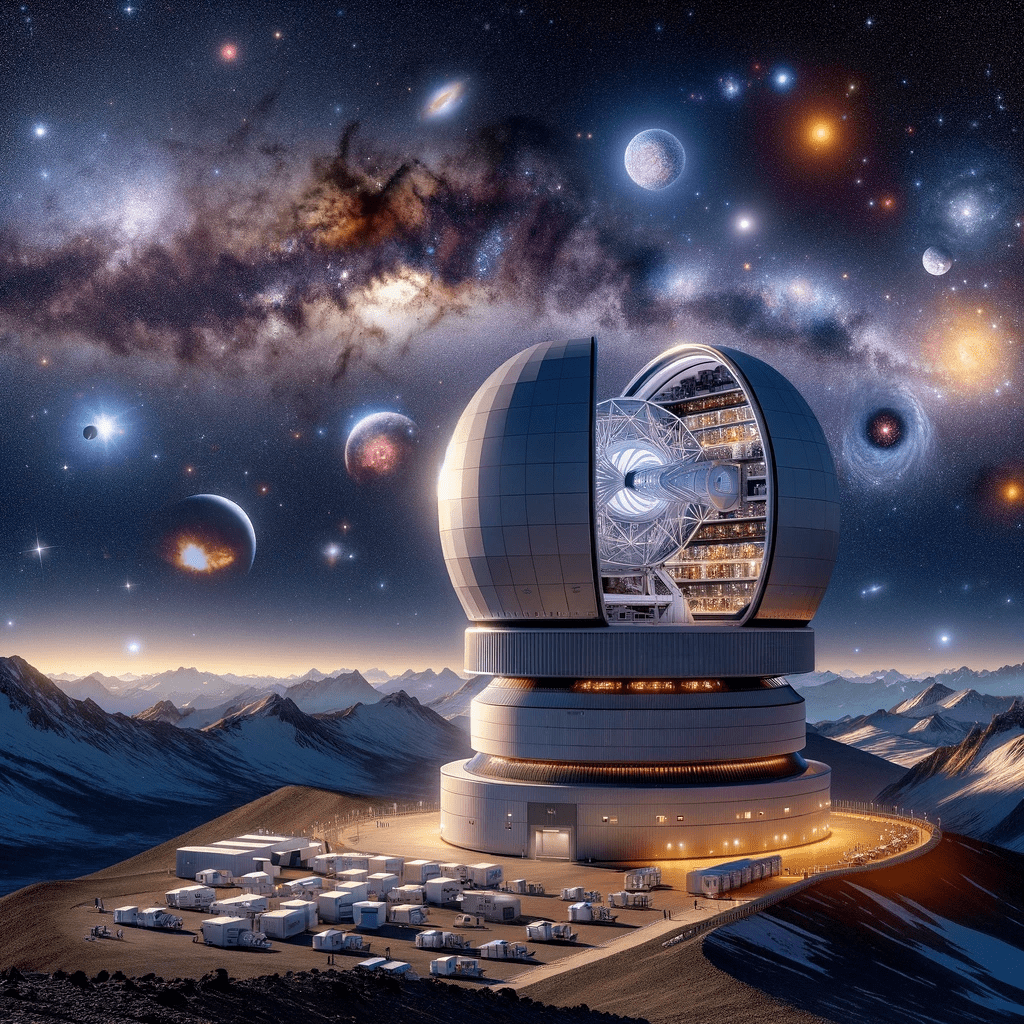Vera C. Rubin Observatory

The Vera C. Rubin Observatory, formerly known as the Large Synoptic Survey Telescope (LSST), is a state-of-the-art ground-based astronomical observatory that aims to revolutionize our understanding of the universe. This innovative facility is located on the Cerro Pachón ridge in Chile and was named in honor of the pioneering American astronomer Vera Rubin, who discovered strong evidence for dark matter’s existence. Construction began in 2015, and the observatory is expected to commence its decade-long survey in 2024. The Rubin Observatory is a collaboration between numerous institutions, including the United States National Science Foundation (NSF), the Department of Energy (DOE), and the Association of Universities for Research in Astronomy (AURA). It will address a wide array of research questions, ranging from dark matter and dark energy to the formation of galaxies and the nature of transient phenomena like supernovae.
The Rubin Observatory’s main instrument is the 8.4-meter Simonyi Survey Telescope, which is equipped with a 3.2-gigapixel camera, the world’s largest digital camera. The telescope has a wide field of view that allows it to image the entire visible sky twice a week. This groundbreaking technology will produce an unprecedented volume of data, enabling researchers to uncover the mysteries of our universe and make significant scientific breakthroughs.
The Rubin Observatory will generate approximately 20 terabytes of data per night, which will be processed by a dedicated data management system (Source: Rubin Observatory website). This vast amount of data will enable researchers to create a comprehensive catalog of celestial objects and phenomena, providing insights into the dynamics of the cosmos like never before.
The Rubin Observatory’s Legacy Survey of Space and Time (LSST) will produce a 60-petabyte dataset over ten years, revolutionizing numerous areas of astrophysics and leading to the discovery of millions of previously unknown objects (Source: Ivezic, Z., Kahn, S.M., Tyson, J.A., et al., “LSST: From Science Drivers to Reference Design and Anticipated Data Products”, The Astrophysical Journal, 873(2), 2019). This massive dataset will serve as a treasure trove of information for scientists worldwide.
The Rubin Observatory is designed to be an environmentally friendly facility, utilizing sustainable construction materials, energy-efficient systems, and minimal water consumption practices (Source: Rubin Observatory, “Sustainable Construction”. These measures ensure that the observatory’s environmental impact is minimized while still achieving its ambitious scientific goals.
Experts are enthusiastic about the potential discoveries that the Rubin Observatory will facilitate. For instance, Dr. Robert Blum, the Deputy Director of the Rubin Observatory, has expressed excitement about the observatory’s role in furthering our understanding of dark energy and dark matter, as well as providing valuable data on transient phenomena like supernovae and gravitational waves (Source: Rubin Observatory, “People of Rubin: Dr. Robert Blum”.
Books discussing the Rubin Observatory, such as “Wide-field Astronomy & Technology for the LSST” edited by Zeljko Ivezic, Mario Juric, and Robert Lupton, detail the scientific goals and the technological advances that the observatory will bring to the field of astronomy. The authors highlight the importance of the LSST in mapping the universe and understanding its mysterious components, including dark matter and dark energy.
The Rubin Observatory’s 8.4-meter Simonyi Survey Telescope, with its wide field of view and rapid imaging capabilities, will be particularly effective in finding and monitoring NEOs. Its decade-long Legacy Survey of Space and Time (LSST) will repeatedly scan the sky, which will help identify and track the movement of NEOs over time. This will improve our understanding of their orbits and potential risks they may pose to Earth.
The Rubin Observatory will greatly enhance our ability to detect and catalog NEOs, especially those larger than 140 meters in diameter, which are considered potentially hazardous. However, detecting smaller NEOs remains a challenge, and no single observatory can guarantee the detection of all NEOs. Collaborative efforts between different observatories and telescopes around the world are essential to improve our ability to identify and track these objects.
The Rubin Observatory is expected to detect objects as faint as 24.5 magnitude in a single 30-second exposure, and even fainter objects when combining multiple exposures (Source: Rubin Observatory, “LSST System & Survey Key Numbers”). In terms of size, this means the observatory will be able to detect objects that are a few meters in diameter and larger, depending on their distance and other factors.
The main objectives of the Rubin Observatory include:
- Investigating dark energy and dark matter: The observatory will help researchers better understand these mysterious components of the universe, which make up approximately 95% of its total mass-energy content.
- Mapping the Milky Way: By cataloging billions of stars and other celestial objects, the Rubin Observatory will provide valuable data on the structure and formation of our galaxy.
- Exploring the transient sky: The observatory will monitor transient phenomena such as supernovae, gamma-ray bursts, and gravitational waves, shedding light on the dynamic nature of the cosmos.
- Studying the solar system: The Rubin Observatory will detect and track Near-Earth Objects (NEOs), improving our understanding of the orbits and potential risks posed by these objects.
While the primary focus of the Rubin Observatory is not to search for UFOs or UAPs, its advanced capabilities and wide field of view may inadvertently capture images of such phenomena.


